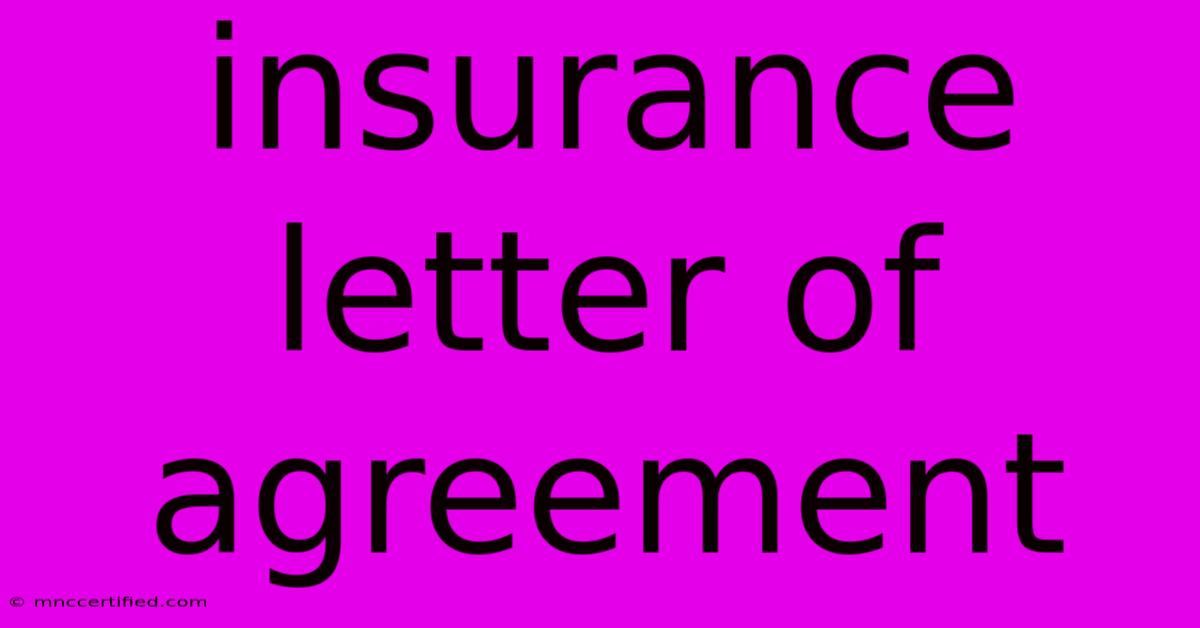Insurance Letter Of Agreement

Table of Contents
Insurance Letter of Agreement: A Comprehensive Guide
An insurance letter of agreement is a crucial document outlining the terms and conditions between an insurance company and its policyholder, or between two insurance companies. This legally binding agreement clarifies responsibilities, coverage details, and dispute resolution processes. Understanding its nuances is vital for both individuals and businesses. This guide will delve into the key aspects of an insurance letter of agreement, covering its purpose, essential components, and potential implications.
What is an Insurance Letter of Agreement?
An insurance letter of agreement, often abbreviated as ILA, is a formal written document that acts as a contract between parties involved in an insurance claim or policy. It's not a replacement for the main insurance policy, but rather a supplementary document that clarifies specific aspects of the agreement or settles disputes. Think of it as a detailed roadmap clarifying the path towards a resolution. It might be used in various scenarios, including:
- Settlement of a claim: Outlining the terms of a settlement reached between the insurer and the insured.
- Subrogation agreements: Defining the responsibilities between insurers when one insurer seeks reimbursement from another.
- Reinsurance agreements: Setting the terms between a primary insurer and a reinsurer.
- Clarifying policy ambiguities: Addressing any uncertainties or gray areas within the primary policy document.
It's essential to remember that the ILA must adhere to all applicable laws and regulations.
Key Components of an Effective Insurance Letter of Agreement
A well-drafted insurance letter of agreement should include the following crucial elements:
1. Identifying Parties:
- Clearly state the names and addresses of all involved parties (insured, insurer, other relevant entities). This ensures no ambiguity about who is bound by the agreement.
2. Date and Reference Numbers:
- Include the date of the agreement and any relevant policy or claim numbers for easy tracking and identification.
3. Subject Matter:
- Explicitly state the purpose of the agreement, for example, "Settlement of Claim No. 12345," or "Subrogation Agreement regarding accident on June 15th." This provides immediate context.
4. Detailed Terms and Conditions:
- This is the core of the agreement. It must outline the specific commitments of each party. For example, in a claim settlement, it should detail the amount to be paid, the release of liability, and any conditions attached to the payment. For a subrogation agreement, it will specify the amounts to be reimbursed and the process for doing so. Ambiguity here can lead to future disputes.
5. Payment Schedule (if applicable):
- If payment is involved, the agreement should clearly specify the payment amount, schedule, and method.
6. Confidentiality Clause (if applicable):
- Many insurance agreements contain confidentiality clauses to protect sensitive information involved in the claim or dispute.
7. Governing Law and Jurisdiction:
- Specify which state's or country's laws will govern the agreement and where any disputes will be resolved. This avoids future jurisdictional battles.
8. Signatures and Dates:
- All parties involved must sign and date the agreement to demonstrate their acceptance of the terms.
Potential Implications of an Insurance Letter of Agreement
Understanding the implications of signing an ILA is paramount. Improperly drafted or poorly understood agreements can lead to:
- Unintended Legal Consequences: Failing to fully grasp the implications of the agreement could result in unforeseen legal liabilities.
- Financial Losses: An agreement that doesn't accurately reflect the parties' intentions can lead to significant financial losses for one or both parties.
- Protracted Disputes: Ambiguous or incomplete agreements often lead to lengthy and costly disputes.
Seeking Professional Advice
Given the complexity and legal implications, it's strongly recommended to seek legal counsel before signing any insurance letter of agreement. A lawyer can help you understand the terms, negotiate favorable conditions, and ensure the agreement protects your rights and interests. Don't underestimate the importance of professional guidance in this area.
Conclusion
An insurance letter of agreement is a critical document that clarifies the terms and conditions between parties in insurance-related matters. By understanding its key components and potential implications, and by seeking professional advice when necessary, individuals and businesses can mitigate risks and ensure fair and effective resolutions to insurance-related issues. Remember, a well-drafted ILA is a vital tool for protecting your interests.

Thank you for visiting our website wich cover about Insurance Letter Of Agreement. We hope the information provided has been useful to you. Feel free to contact us if you have any questions or need further assistance. See you next time and dont miss to bookmark.
Featured Posts
-
Singer Blasts Gregg Wallace
Nov 29, 2024
-
What Channel Shows Nice Vs Rangers
Nov 29, 2024
-
Wallace Among 13 Master Chef Exits
Nov 29, 2024
-
Thanksgiving Early Black Friday 2024 Deals
Nov 29, 2024
-
Nfl Fans Troll Bears Harlow Hype Shaboozey
Nov 29, 2024